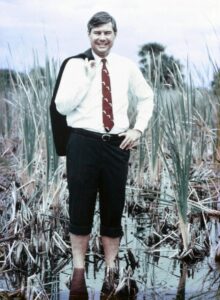1000 Friends of Florida invokes the popular governor’s legacy, calling for more rigorous growth management.
By Noah Vinsky
Original Air Date: September 27, 2024
Host: An environmental group is praising the achievements of the late Governor Bob Graham for planning in Florida. That nostalgic view of past achievements contrasts with recent and current trends in planning in the state. WSLR’s Noah Vinsky reports.
Noah Vinsky: Visionary and detail-oriented with a hands-off management style — these were three attributes of late Florida governor and United States senator Bob Graham, who passed away this April at the age of 87.
1000 Friends of Florida, an environmental advocacy organization, hosted a webinar Wednesday afternoon to honor Graham’s legacy and impact on Florida’s planning policy framework.
Bob Rhodes, a former 1000 Friends of Florida , discussed some of the landmark events from Graham’s governorship. That included the formation of the Environmental Land Study Committee, known as ELMS, which created a tiered system of state, regional, and local environmental plans.

Bob Graham
Bob Rhodes: This task force developed significant recommendations to strengthen regional and state planning, and which furrowed the ground for the work of a second ELMS committee. That would be ELMS 2, which I chaired. Before he announced the creation of ELMS 2, Governor Graham asked me to come to his office, and we had the conversation about goals, and he looked at me and he said, “Bob, put your helmet on. This group is going to be the most diverse I’ve yet appointed. Every major interest group will be represented. It will be bipartisan. It will include legislative leaders.” And then he paused and he said, “It’s also going to include John DeGrove and Nat Reed,” the co-founders, of course, of A Thousand Friends of Florida.
NV: Rhodes called Florida a “growth magnet” in the late 1960s that suffered from a lack of local planning programs. This began to change under Graham’s leadership, when in 1972, he co-sponsored a set of planning and environmental legislation, including the Environmental Land and Water Act, as well as the Water Resources Act. Rhodes said that Graham “took charge” of the issue.
BR: And with the watershed 1970 election, new state leaders Governor Rubin Askew, Speaker Dick Pettigrew, Representative Buddy McKay, and newly elected State Senator Bob Graham, who were sensitive to the challenges and demands of new growth, took charge. Conferences were convened, task forces appointed, studies begun to develop a path forward.
NV: Florida now looks a lot different than Florida fifty years ago. Recent administrations have dismantled much of the planning process. Board member Victoria Tschinkel emphasized the continuous need for growth management in the midst of a statewide population boom.
Victoria Tschinkel: Now it’ll probably appear to you that we didn’t quite finish the job. So defensively I’m going to remind you that Florida is desperately fragile, and the demands placed on it are directly proportional to the growing population. When Bob Graham left office at the beginning of 1987, the population was 11.6 million. In 2023 — let’s pretend that’s now — it had doubled to 22.5 million. Doubled. So we understand that if elected officials don’t keep up day-to-day with the demands of Florida’s environment and needs for growth management, and the citizens don’t, we’re sunk.
NV: This has been Noah Vinsky reporting for WSLR News.
WSLR News aims to keep the local community informed with our 1/2 hour local news show, quarterly newspaper and social media feeds. The local news broadcast airs on Wednesdays and Fridays at 6pm.